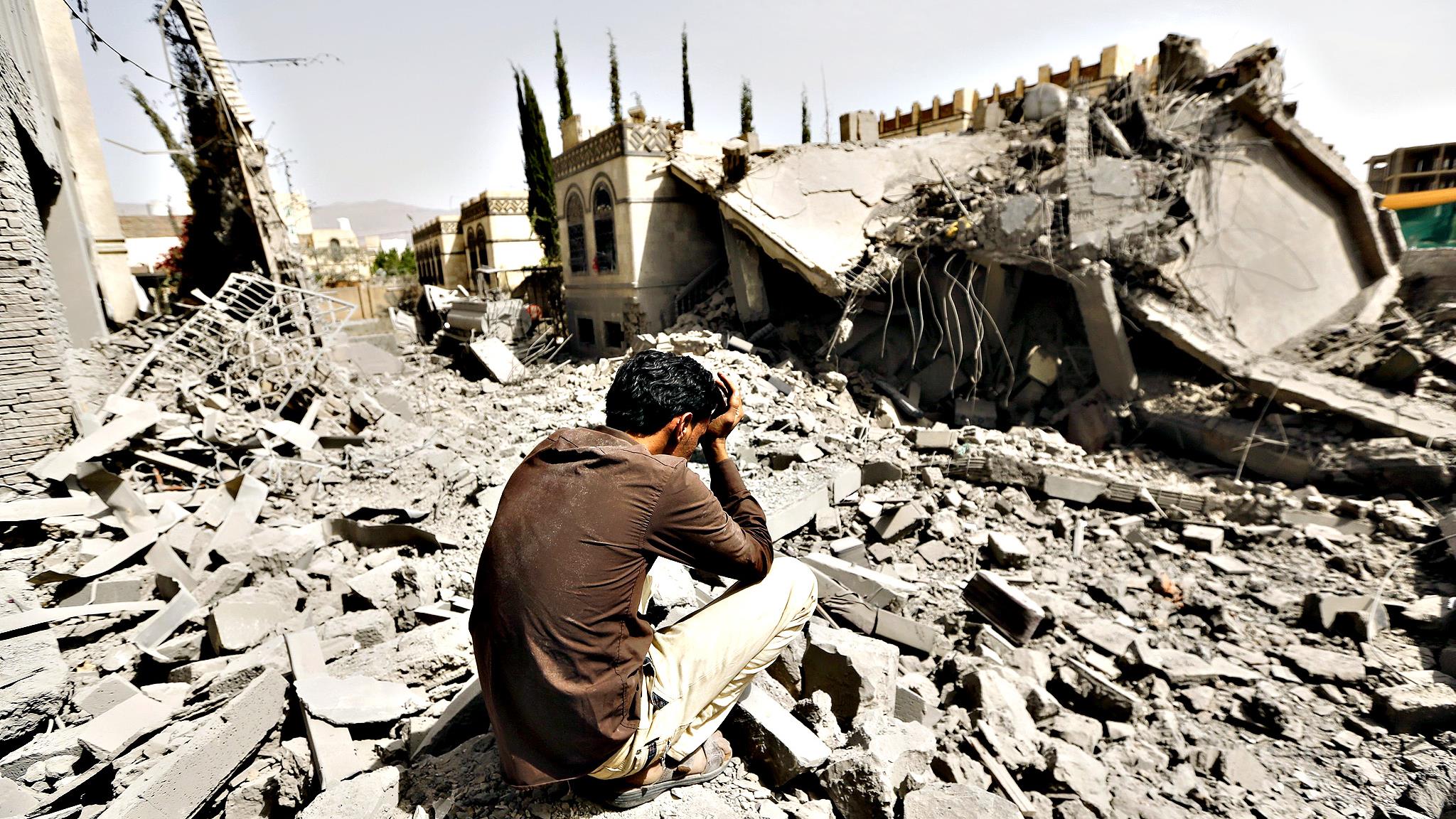In the last week of October, the civil war in Yemen reached a new measurable depth of horror and tragedy. The total death in Yemen’s civil war has now reached 100,000. That death toll includes more than 12,000 civilians. Twenty thousand of those deaths occurred this year. Last year, the charity organization Save the Children announced that as many as 85,000 children under the age of 5 years old may have died from hunger brought on by famine in Yemen. Saudi airstrikes have hit schools, hospitals, and weddings, killing thousands of civilians. Kidnappings, rape, and starvation are now regular occurrences in the Yemen Civil War.
This is the short story version of how the civil war in Yemen came about and everything you need to know to understand this chaos.

Yemen is located on the Saudi Arabian border. Its strategic importance is linked to its location on a narrow waterway that links the Red Sea with the Gulf of Aden. Much of the world’s oil shipments pass here. The total population of about 25 million is distributed across a landmass roughly the size of California. Historically it is one of the poorest nations in the Middle East.
Yemen is historically divided between Sunni (65%) and Shia (35%) Muslims. The Shia occupy the lands of the north, the Sunni are largely located in the lands of the southeast. In recent years this religious divide has been highlighted on top of divisions that existed since the days of the British colony in the southern part of the country.
The modern state of Yemen was formed in 1990. Prior to this, the nation existed as two separate entities, a reflection of Cold War politics that perpetuated divisions of the colonial period. During the Cold War, the United States and Saudi Arabia backed the Yemen Arab Republic. The Soviet Union backed the People’s Democratic Republic of Yemen.

Ali Abdullah Saleh who ruled North Yemen Arab Republic since 1978 assumed leadership of the new country in 1990. His rule was marked by corruption and authoritarianism until the Arab Spring in 2011.

Al-Qaeda has been active in Yemen since the early 1990s. In 2007 al Qaeda in Yemen and Al-Qaeda in Saudi Arabia united to form Al-Qaeda in the Arabian Peninsula (AQAP). Saleh has been supported by the US and Saudi Arabia in the fight against al Qaeda, but his motives and levels of commitment were frequently in question.
Who Are the Houthis in Yemen
In the early 2000s, the Houthi Insurgency began. The Houthis began as a Shia religious movement. Their name is derived from the movement’s founder Hussein al Houthi.

Although there is a linkage between the Houthis and Iran, this linkage should not be overstated. There are various branches of Shia Islam. The branch of Shia Islam practiced in Iran, for example, is closely linked to a belief in the Ayatollahs. The branch practiced by the Houthis in Yemen is not. The Shia Islam practiced by the Houthis in Yemen is tightly associated with a fight against corruption. That is only one difference but a significant one in understanding the background of the war in Yemen.
The Houthis saw Ali Abdullah Saleh as corrupt and the perfect target for their religion and frustration. He was supported by the west and the Saudis. He was also looting the already poor nation for his own private financial benefit.
The 2003 US invasion of Iraq helped to further radicalize the Houthis. They modeled themselves off of Hezballah in Lebanon and received support from Iran. Ali Abdullah Saleh’s forces killed Hussein al Houthi in 2004. Yemeni forces suppressed Houthis forces in the northwestern part of the country with increasing assistance from the Saudis.
In spite of the massive support received from the Saudis and the loss of the founder and leader, the Houthis, time and again, defeated Saleh’s forces.
Beginning of the Civil War in Yemen
The Arab Spring of 2011 included the ouster of Saleh from power in Yemen but that did not necessarily mean a victory for the Houthis. A new Sunni leader of Yemen and Saleh’s former vice president, Abdrabbuh Mansour Hadi, was viewed as dangerous to the interests of the Houthis. To much of the world’s surprise, the Houthis began to secretly partner with the ousted leader, not to mention their former enemy, Salah to fight against the new leader Hadi.

The army remained loyal to Saleh and Hadi was seen as a puppet to the Saudis. In 2015 the capital of Yemen, Sana’a, fell to the rebels. Relations and trade between Yemen and Iran were quickly improved and the Saudis saw an immediate escalation of threats to their southern border from their regional nemesis in Iran. The Houthis went on to capture the major port city of Hodeidah and began making moves toward Aden. Aden is the largest city in the southern part of Yemen and the largest port on the Indian Ocean.
The Saudis opted to go to full-scale war against the Houthi rebellion. They were backed and supported by the US and the Obama administration at the time. The US support of the Saudis triggered a proxy war in the region. In this proxy war, Iran and the Saudis are fighting against one another using Yemen’s lives and deaths as their proxy agents. The war has pushed the Houthis and Iranians closer together than ever before. It has also highlighted the humanitarian nightmare being pushed by both sides.

In early 2017 the US confirmed it was not only supporting the Saudis with weapons and intelligence but was also directly involved in airstrikes. Although President Obama’s administration implemented and initiated the US policy of alliance and support to the Saudis in the war in Yemen, President Trump further escalated it. More US strikes were directed against Yemen in President Trump’s first 100 days in office than President Obama’s last two years combined.
Escalation of the Chaos
By 2016 the United Nations was referring to the war in Yemen as the worst humanitarian crisis on the planet. This announcement occurred even while wars were raging in Syria and Afghanistan. Families were having to choose between saving their sick children or feeding their healthy children. The New York Times noted that desperate families in Yemen were selling their daughters as child brides and allowing their sons to be recruited as child soldiers. They could not afford to care for them any longer. Families received $55 every three months for giving their sons to fight. The head of the United Nations noted that a child under the age of 5 was dying every ten minutes in Yemen.

In 2017 a cholera outbreak hit the country with an estimated 3,000 to 5,000 new cases every day. Half of the cholera victims were children. Yemen’s currency was also in danger of complete collapse causing food prices to soar. What food that can be found in Yemen today is largely sourced from international aid agencies.
Gender-based violence and atrocities has also become a hallmark of this war. Forces loyal to the United Arab Emirates and Saudi Arabia have kidnapped women and girls. The same is occurring on the Houthis side. The Houthis are kidnapping women and girls and holding them for ransoms from their families. Rape and sexual assault are widespread. War crimes are rampant on both sides of the fighting.

A Saudi Arabian blockade on the port city of Hodeida meant to starve the Houthis into submission triggered famine in the country. Ironically, perhaps hypocritically, even while Saudi Arabia has dropped billions of dollars worth of American bombs on Yemen they routinely offer the largest public pledges for donations to humanitarian aid in Yemen.
Civil War Within the War
By the beginning of 2018, the war entered a new phase as a civil war within the war began to unfold. As the fighting between the Houthis and the Saudi backed forces of Hadi seemed stuck in a stalemate, the two sides began imploding into themselves.

On the Houthi side, the Houthis turned on Saleh. The former leader of Yemen was killed when he was found reaching out for a truce with Hadi in an effort to betray the Houthis and regain power for himself.
Meanwhile, in south Yemen forces loyal to Hadi began turning on him. The forces converged into a separatist group known as the Transitionary Southern Council and sponsored by the United Arab Emirates. These forces and the UAE accused Hadi of being corrupt. They set up a series of secret prison facilities in the south of Yemen and an internal civil war broke out on the Saudi side of this proxy war. Hadi accused the UAE of acting as an occupying force in southern Yemen.
This civil war has persisted all the way to this month when a series of agreements were finally concluded and supposedly brought an end to the divisions on the Saudi side of the proxy war.
By 2019 ISIS and al Qaeda also entered the fighting, each fighting for influence and territory within the war-torn nation. This addition has further fragmented the country pitting one tribe’s loyalty against the other. In the month of September alone there were nearly 30 attacks between ISIS and al Qaeda forces.






[…] can learn more about the war in Yemen here. This includes history and a look at the major players in […]